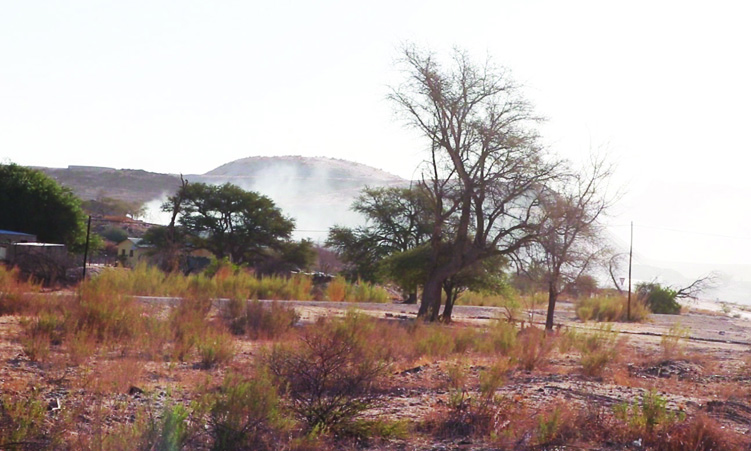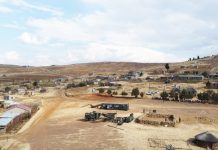
By Tracy Tafirenyika | December 17, 2024
Residents and former workers in Uis, where the United Kingdom’s Andrada Mining operates a tin mine, accuse the company of endangering both employees and the community by exposing them to health hazards.
They also fear that blasting at the mine is damaging their homes, causing cracks in walls and floors.
The company denies the accusations, and some local authorities say residents haven’t filed formal complaints.
But the worries persist one year after the Ministry of Mines and Energy ordered the company to remove some of its explosives and to rehabilitate an area that had been blasted just 500 metres from a residential area.
A 2021 report by the Office of the President and the National Planning Commission says residents have complained about health issues.
“The community indicated that due to mining operations, they were exposed to air pollution due to dust, resulting in respiratory health issues such as coughing among children as well as tuberculosis (TB) cases,” the report reveals.
“Another environmental effect was noise pollution and underground vibrations as a result of the blasting which causes cracks in houses.
There were also concerns that mines bring about degradation and deforestation,” the report reads.
FORMER WORKER’S DILEMMA
Current and former employees told The Namibian they worry that the mine’s dust pollution is causing asthma and TB.
Maoth Areses (52) worked as a mineworker for ten years before joining the Uis Tin Mining Company as a fulltime employee in 2019.
But she started feeling ill in 2021.
Her medical report revealed that she has asthma so severe she had to resign.
“I started to experience chest pains, shortness of breath and dizziness from November 2021,” Areses says.
In her resignation letter dated 28 August 2023, Areses said she wished the company had better working conditions.
“As a result of my sickness that I contracted while being part of your workforce, my sick leave is being depleted, which results in unpaid leave,” she wrote.
She added: “At the end of the day, the situation that I am in is the same as me being at my home rather than to be exploited in this manner.”
Other Uis residents and mineworkers are battling with the same dilemma.
The Uis Tin Mining Company operates under Andrada Mining – a UK-based company formerly known as AfriTin Mining.
Opened in 2017, the mine produces lithium, tin and tantalum.

EXCESSIVE COUGHING
One current employee, who prefers to be anonymous, says since working at the mine, he has battled with excessive coughing.
“When the mine opened, we were all happy that it would finally bring change in our community in terms of employment,” he says.
“The mine also tested me for any respiratory-related diseases before I started working there and I was completely fine.
“I do want to work there and provide for my family, however, my health has become my biggest concern and I cannot work properly because I am always taking leave.”
UNION VOICE OUT
Small-Scale Miners of Uis Union spokesperson Morris Seibeb told The Namibian that the mine is impacting its workers and the community in general.
“The people who are working in the mine, they are not getting good treatment from the mine.
They just use the people in the dust, and the people are getting sick. And the dust is also entering our location where we are staying and a lot of people are getting TB and asthma from that dust,” he says.
He says the mines should move away from the community.
“The people must take the mines a bit far from the community because it is too close to the residents,” Seibeb says.
“Many people who are working at that mine have approached me regarding these cases, however, most of them are the elderly people that are leaving the area,” he says.
Seibeb also says more than 30 homes were damaged by the mine’s blasting.
The blasting is allegedly causing dust to settle at NamClay Bricks and Pavers, a local company that makes clay bricks from mine waste.
“It is actually the mines that produce the dust, especially when they are blasting.
The dust is not coming from our factory,” NamClay managing member Albert Weitz says.

ELDERS WITH ASTHMA
Ingrid Tauros (50) lives about 200m from NamClay.
“When the mine is blasting, it raises dust from the bricks they manufacture, and my asthma gets worse,” she says. “But I live here, this is my house. I can’t go anywhere.”
NamClay should have been set up at least five kilometres out of town, she says.
“Every time the mine explodes, our houses are also shaking and that’s a problem,” she says.
“There are also small kids who are only growing up now and this dust, blasting and smoke from the mine will have an effect on these small innocent children one day.”
Vincentius Shilongo (74) says his health worsens daily.
“When they begin to burn the materials, our houses are completely under the smoke,” he says.
Mini Uiseb, a senior registered nurse in charge of the Uis state clinic, told The Namibian that asthma especially affects the elderly, but that there is no way to track the cases.
“The mines have their own protocols on their safety and their workers and employees are taken to Swakopmund.
They are not brought here for their medical examinations, so we cannot track them to say people at the mine have been getting TB because of the mine or mine dust,” he says.

BLASTING CONCERNS
Alexia Gauses (48) says she fears for her life.
“When I came in this house, these scratches on the floor were so little, but after the mine was opened, when they are blasting, the houses are shaking and they are getting more and more open,” she says.
“When the mine is shooting, even the kids are getting scared. Sometimes, you think the house will fall on you,” Gauses says.
When The Namibian visited Uis in December last year, the mineworkers’ homes were cracked.
“When they blast, our house walls crack, and now there are cracks all over our houses,” says community activist McDonald Gawaseb.
“Every day we are surrounded by dust, and we are inhaling the dust and the dangerous substances that the mine is producing.”
Gawaseb says the company’s mining activities have affected the community.
“The government is not doing anything to protect our health,” he says. “We want our health to be addressed as soon as possible, and we want to be compensated for the cracks in our houses.”

COMMUNITY ACTIVIST
“Dust pollution taking place in Uis is a severe health concern for residents, yet it has not been adequately addressed,” says community activist Jimmy Areseb (28).
“The rehabilitation process, especially in the event of mine closures, raises questions about how these areas will be restored,” he told The Namibian.
“Previous mining companies in the area left two open pit areas, resulting in the tragic loss of two lives in recent years,” he says.
Social welfare group Development Aid from People to People (DAPP) says miners are at higher risk of getting TB.
This evidence led DAPP to establish the ‘TB in the Mining Sector in Southern Africa Programme’ in 2016, in cooperation with the Ministry of Health and Social Services.
“TB is an infectious disease and miners are at higher risk of getting TB due to the type of environment they are working in, and the dust (silica) they are inhaling, overcrowdedness, poor ventilation and migration,” its report says.
Ministry of health executive director Ben Nangombe acknowledges health risks faced by mineworkers.
“As the Ministry of Health and Social Services, we encourage individuals, especially small-scale miners, to take necessary precautions to prevent infections caused by mining activities.
Mining operations typically generate dust containing elements that contribute to TB infections and other respiratory diseases,” he says.

ANDRADA RESPONSE
Andrada Mining refutes allegations of air pollution and infrastructure damage at the town.
Cath Drummond, the company’s associate director, told The Namibian in January that result
s from a recent report confirm that dust-related concerns within the community of Uis are not mining-related.
The company has declined to share the report, citing confidentiality.
“An independent third-party consultant also records all instances of blasting on-site and carries out seismic analysis following each blasting event.
“These results confirm that, at no point have shockwaves been sufficient to cause damage to infrastructure in the surrounding area,” Drummond said.
“The company maintains exemplary relations with its host community of Uis, conducting quarterly meetings in the town of Uis with local stakeholders, known as Settlement Development Committee meetings. During these meetings, the company has not been notified of any of these allegations,” she added.
Drummond said Andrada Mining contracts an independent third-party environmental consultancy to regularly conduct a air quality depositional (fallout) dust monitoring report.
“Surrounding the area of current blasting operations, within the ML 134 licence alone, there are 20 third-party air quality-monitoring receptors, all of which have observed no exceedances in permitted air quality thresholds, including harmful chemical content.”
Drummond said the Ministry of Mines and Energy has never complained.
Uis senior traditional councillor Herman Naruseb says he was not aware of the dust pollution or cracked homes.
“It is actually my first time to hear that someone is sick because of the dust, “ he says.
Naruseb says the mine has brought jobs, but it does not offer any other benefits to the community.

BLASTING CONCERNS
Responding to the mines ministry ordering the company to remove explosives and rehabilitate an area that had been blasted just 500m from a residential area, Andrada country liaison manager Elizabeth Manasse on Saturday said the mining licence ML129 referred to is no longer part of the company’s portfolio.
“The licence is now owned by the Small Miners of Uis. During its ownership, Andrada adhered to all governmental and mining legislation, without exception. Regarding the area in question, government approval for blasting activities had initially been obtained,” she said.
“However, this approval was subsequently withdrawn before any blasting or related works were carried out. As a result, no blasting occurred within 500 metres of any residential area, and the claim suggesting otherwise is incorrect,” she said.
Manasse denied infrastructure damage in the community that is allegedly being caused by blasting.
“Buildings in the mining precinct that could be considered most vulnerable in terms of blasting have not developed any cracks or damages since construction,” she said.
She said the claim that blasting activities are causing cracks in nearby homes is not new to the company and has been thoroughly investigated in collaboration with the concerned parties.
Regarding Areses’ allegations, Manesse confirmed that the company has addressed the situation.
“Uis mine will not reveal personal information about Areses but can confirm that the company provided Ms Areses with occupational pathway options.
“The company addressed the situation with a collaborative approach and flexibility and remained accommodating to the medical needs of Ms Areses, including provision of specialist medical attention,” she said.
See the full response from Andrada Mining on The Namibian’s website
– This article was produced by The Namibian’s investigative unit. Send us story tips via your secure email to investigations@namibian.com.na





